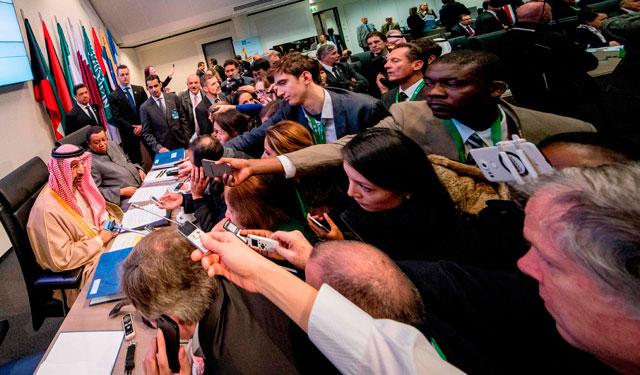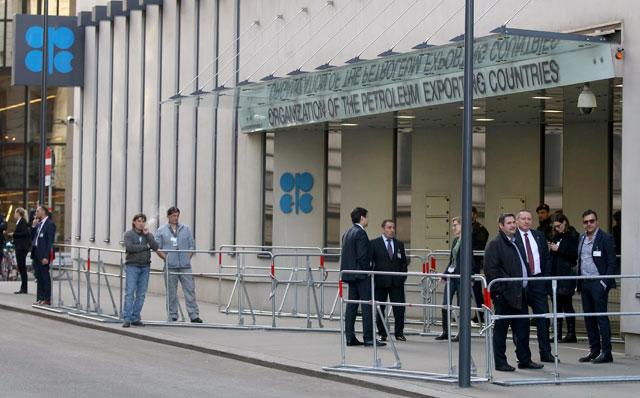You are here
OPEC, non-opec extend oil output cut by nine months to fight glut
By Reuters - May 25,2017 - Last updated at May 25,2017

OPEC president, Saudi Arabia’s Energy Minister Khalid Al Falih, and OPEC Secretary General Mohammad Barkindo talk to journalists before a meeting of the Organisation of the Petroleum Exporting Countries in Vienna, Austria, on Thursday (Reuters photo)
VIENNA — The Organisation of the Petroleum Exporting Countries (OPEC) decided on Thursday to extend cuts in oil output by nine months to March 2018, OPEC delegates said, as the producer group battles a global glut of crude after seeing prices halve and revenues drop sharply in the past three years.
The cuts were also shared by a dozen non-members led by top oil producer Russia, which reduced output in tandem with OPEC from January.
OPEC’s cuts have helped to push oil back above $50 a barrel this year, giving a fiscal boost to producers, many of which rely heavily on energy revenues and have had to burn through foreign-currency reserves to plug holes in their budgets.
Oil’s earlier price decline, which started in 2014, forced Russia and Saudi Arabia to tighten their belts and led to unrest in some producing countries, including Venezuela and Nigeria.
The price rise this year has spurred growth in the shale industry of the US , which is not participating in the output deal, thus slowing the market’s rebalancing with global crude stocks still near record highs.
By 11:50 GMT, Brent crude had fallen 1.3 per cent to around $53 per barrel as market bulls were disappointed OPEC would not deepen the cuts or extend them by as long as 12 months.
In December, OPEC agreed its first production cuts in a decade and the first joint cuts with non-OPEC, led by Russia, in 15 years. The two sides decided to remove about 1.8 million barrels per day from the market in the first half of 2017, equal to 2 per cent of global production.
Despite the output cut, OPEC kept exports fairly stable in the first half of 2017 as its members sold oil from stocks.
The move kept global oil stockpiles near record highs, forcing OPEC first to suggest extending cuts by six months, but later proposing to prolong them by nine months and Russia offering an unusually long duration of 12 months.
“There have been suggestions [of deeper cuts], many member countries have indicated flexibility but ... that won’t be necessary,” Saudi Energy Minister Khalid Al Falih said before the meeting.
Cuts exclude Nigeria and Libya
He added that OPEC members Nigeria and Libya would still be excluded from cuts as their output remained curbed by unrest.
Falih also said Saudi oil exports were set to decline steeply from June, thus helping to speed up market rebalancing.
OPEC sources have said the Thursday meeting will highlight a need for long-term cooperation with non-OPEC producers.
“Russia has an upcoming election and Saudis have the Aramco share listing next year so they will indeed do whatever it takes to support oil prices,” said Gary Ross, head of global oil at PIRA Energy, a unit of S&P Global Platts.
OPEC has a self-imposed goal of bringing stocks down from a record high of 3 billion barrels to their five-year average of 2.7 billion.
“We have seen a substantial drawdown in inventories that will be accelerated,” Falih said. “Then, the fourth quarter will get us to where we want.”
OPEC also faces the dilemma of not pushing oil prices too high, because doing so would further spur shale production in the United States, the world’s top oil consumer, which now rivals Saudi Arabia and Russia as the world’s biggest producer.
“A nine-month extension is insufficient at shale’s current trajectory. The strategic challenge of shale is still to be addressed,” said Jamie Webster, director for oil at Boston Consulting Group.
Related Articles
VIENNA — The Organisation of Petroleum Exporting Countries (OPEC) agreed on Thursday to extend oil output cuts until the end of 2018 a
VIENNA — OPEC and non-OPEC producers on Saturday reached their first deal since 2001 to curtail oil output jointly and ease a global glut af
ABU DHABI — The Organisation of Petroleum Exporting Countries (OPEC) will discuss extending production cuts that have boosted oil prices and



















